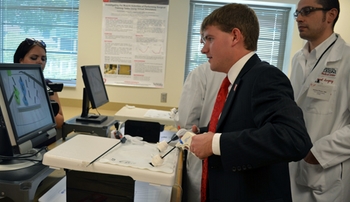He was nominated because he was young and, as one of his senior colleagues said, “better at video games.”
“Young people who play video games do seem to have an easier time with this technology,” surgical resident Avishai Meyer, M.D., said to the University of Nebraska Regents who had gathered in the Center for Advanced Surgical Technology in Swanson Hall.

|
|
Eric Kamler, center, the student regent from the University of Nebraska-Lincoln, tries his skills Friday on a laproscopic surgery simulator in the UNMC Center for Advanced Surgical Technology. Kamler and other University of Nebraska Regents were at UNMC for tours and their monthly meeting. |
And with that, Eric Kamler, the student regent from the University of Nebraska-Lincoln, stepped up to a robotic laproscopic surgery simulator and attempted to move a foam tube around a small peg board.
Not as easy as it looks
“You’re not going to be operating on me,” NU President James B. Milliken said as Kamler struggled to manipulate the robotic arms and move the tube.
“That’s why they leave me on the farm, J.B.,” said Kamler, an agricultural economics major.
It took longer than he would have liked, but Kamler finally moved the tube to a new peg.
A second attempt
He finished just in time to try again, this time on a simulator that mimics surgeries performed through the navel.
As Kamler labored again, a CAST team member explained to the regents, who were at UNMC on Friday for tours and their monthly meeting, that laproscopic surgery — with its smaller incisions and shorter recovery — is easier on patients but harder on surgeons.
The small incisions and confined space makes surgeons contort their hands a lot. This brings strain, stress and chronic pain.
The robotic tools designed in the CAST lab aim to make life easier for patients and surgeons.
One more time just for good measure
Kamler failed on the navel simulator but got a final shot on a simulated miniature surgical robot that CAST director Dmitry Oleynikov, M.D., said could be the future of surgery.
As he watched a two-dimensional television screen and directed the robotic forceps, Kamler completely whiffed on a few attempts to grab the tube before he was able to get a grip.
But once he did, he used the control handle to pick up the tube and move it gently onto another peg.
A new appreciation
On the way out of the lab, UNMC Chancellor Harold M. Maurer, M.D., lauded Kamler for his efforts.
“After that and seeing all that technology, I have much greater respect for surgeons and what they do,” Kamler said.